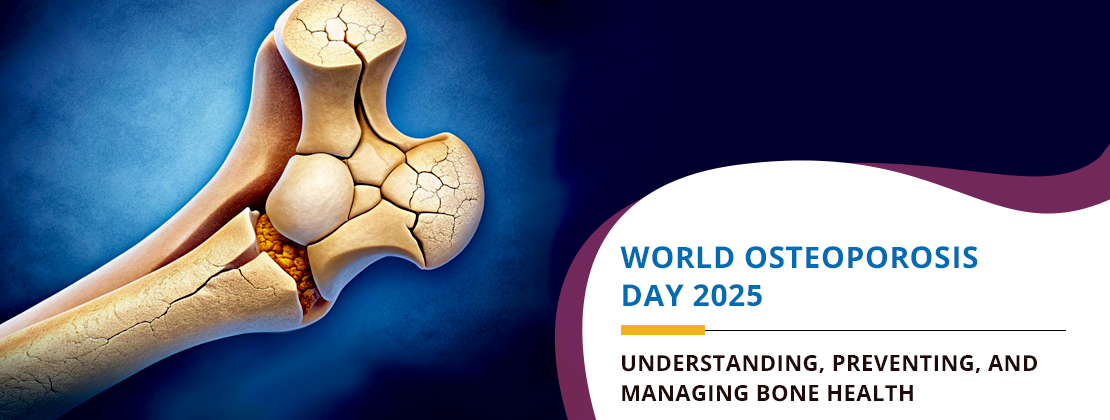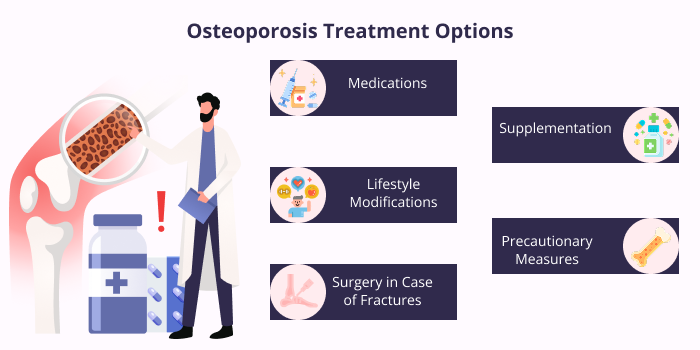
Home / Blog / World Osteoporosis Day 2025: Understanding, Preventing, and Managing Bone Health
October 17, 2025
Our world sees about 500 million osteoporosis cases every year. 1 in every three women and 1 in every five men aged 50 and above will have an osteoporosis fracture once in their lifetime.
But do you know what’s even more alarming? About 80% of the people who have osteoporotic fractures do not receive a follow-up diagnosis or necessary treatment.
These statistics clearly show us where we stand in terms of awareness about bone health, bone disease management, and bone disease prevention.
With the World Osteoporosis Day article around, there is no better time than now to learn about the key aspects of osteoporosis, including its symptoms, treatment options, and prevention.
Every year on October 20, the entire world observes World Osteoporosis Day to promote awareness about bone health, how to avoid fragile fractures, and the need for better prevention and care.
The theme for the World Osteoporosis Day 2025 campaign is “It’s Unacceptable! The Overlooked Crisis in Osteoporosis Prevention and Care.”
It calls for immediate action to close gaps in diagnosis, treatment, and support around the world. The major goal is to help people understand what osteoporosis is, how to detect it, and how to effectively treat and prevent it with appropriate interventions.

Osteoporosis is a disease that makes bones less dense and weaker, which increases the risk of fractures from mild accidents or traumas.
Osteoporosis generally does not cause any symptoms until a fracture occurs; therefore, regular monitoring and early treatment are very important.
Vitamin D deficiency, thyroid hormone imbalance, small body frame, tobacco and alcohol consumption, prior fracture, family history, and increasing age are some of the risk factors for osteoporosis.

Osteoporosis progresses incrementally and may remain asymptomatic until a fracture occurs in any part of the body.
The following are the different osteoporosis symptoms that one must keep an eye on:
If you see any of these signs, talk to your doctor about getting a bone density test (DEXA).
DEXA (Dual-Energy X-ray Absorptiometry) Scan: Considered the gold standard for osteoporosis diagnosis, a DEXA scan measures the bone mineral density, usually in the hip or spine regions, using low-dose X-rays. The results are presented as T-scores; T-scores between -2.5 and -1.0 indicate osteopenia, and T-scores less than -2.5 indicate osteoporosis.
Imaging Tests: In some cases, imaging tests, such as CT scans, X-rays, and ultrasound scans, may be recommended to determine the extent of bone fractures. These tests are less sensitive than DEXA scans.
Blood Tests: Blood tests may be recommended to look for specific deficiencies that increase osteoporosis risk and to look for conditions that affect bone metabolism.
Based on the reports, doctors will come up with the best suitable treatment plan that is going to address the specific health needs of the patient and help them recover.

A carefully devised osteoporosis treatment plan aims to help people prevent fractures, ease their discomfort, and preserve their mobility. Commonly recommended osteoporosis treatment approaches include:
Medications: Bisphosphonates and denosumab are examples of anti-resorptive drugs that can help slow down bone loss. Anabolic agents like teriparatide help the bones grow, improve bone density, and reduce fracture risk.
Supplementation: Doctors recommend addressing vitamin D and calcium deficiencies in order to improve bone health.
Lifestyle Modifications: Consuming healthy foods, exercising regularly, maintaining optimum weight, and refraining from tobacco and alcohol consumption are a few lifestyle modifications to consider to manage osteoporosis and prevent it from becoming severe.
Precautionary Measures: Individuals with weak bones should be careful while walking and moving around. Those with vision problems should be extra careful to prevent accidental falls that could lead to fractures. It is also important for these individuals to make their homes accident-proof.
Surgery in Case of Fractures: In the case of a fracture, surgery may be recommended to restore the alignment and support healing.
To reduce your osteoporosis risk, you need to adopt lifestyle habits that are going to positively impact your bone health. The following are a few helpful osteoporosis prevention strategies:
Healthcare experts play a critical role in osteoporosis management, as they aid in its detection and treatment and provide patients with necessary post-treatment guidelines that will help patients lead a normal life after. Primary care physicians identify individuals with osteoporosis risk and subsequently send them for bone scans.
Endocrinologists and rheumatologists play a critical role in managing advanced conditions caused by weaker bones.
Physiotherapists help people find safe ways to exercise, while pharmacists help people adhere to their medications and supplements.
At leading multispeciality hospitals in Ahmedabad, like HCG Hospitals, there will be a dedicated orthopaedics department where specialists offer comprehensive care, which entails diagnosis, treatment, follow-up, and supportive care. This approach makes care holistic for patients and contributes to their swift recovery.
To connect with the best orthopaedic doctor in Ahmedabad, visit HCG Hospitals today.
World Osteoporosis Day 2025 focuses on drawing attention to the worldwide lack of awareness about this condition. Many individuals are still not aware of the complications that osteoporosis can cause.
Advocacy efforts are aimed at making it easier for people to get screened, developing comprehensive osteoporosis management programmes, promoting general awareness about osteoporosis, and reforming health policies to facilitate more holistic osteoporosis management.
World Osteoporosis Day 2025 is a reminder that we can’t ignore our bone health anymore. If detected early, osteoporosis can be managed effectively. With healthy lifestyle habits and appropriate preventive measures, it is possible to reduce your osteoporosis risk and lead a healthy life.
By eating a lot of calcium, getting enough vitamin D, working out regularly, not smoking, and not drinking too much alcohol, it is possible to improve your bone health and reduce your osteoporosis risk.
World Osteoporosis Day is observed to make people aware of the seriousness of this condition, its risk factors, symptoms, treatment options, and prevention strategies.
Age, gender (female), heredity, smoking, drinking, calcium/vitamin D deficiency, a lack of physical activity, etc., are the key risk factors for osteoporosis development.
Brittle nails, weakened grip strength, unexplained pain and discomfort, and receding gums are often the early signs of osteoporosis.
For osteoporosis diagnosis, doctors recommend a DEXA scan that checks the density of minerals in the bones and the risk of fractures.
Men can also get osteoporosis; however, it is more prevalent among women.
Calcium is considered the building block for our bones. It maintains the bone structure and bone density and prevents bone fractures.
Vitamin D is essential for calcium and phosphorous uptake by the body, which are essential for maintaining optimum bone health.
Walking, jogging, squats, resistance bands, yoga, and Tai Chi are all great activities that help you build strength, balance, and weight.
If there are no fracture risks, you may also consider jumping- and hopping-related exercises.